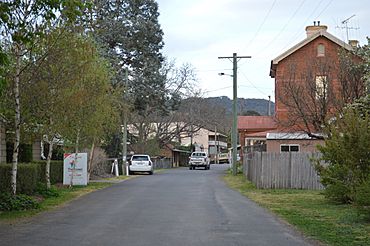Sofala, New South Wales facts for kids
Quick facts for kids SofalaNew South Wales |
|
|---|---|

Denison Street, the unusually narrow main street of Sofala
|
|
| Population | 208 (2006 census) |
| Location | |
| LGA(s) | Bathurst Regional Council |
| State electorate(s) | Bathurst |
| Federal Division(s) | Calare |
Sofala is a small village in New South Wales, Australia. It is about 255 kilometers (158 miles) northwest of Sydney. The village sits right next to the Turon River. Sofala is just off the Bathurst-Ilford Road. In 2006, about 208 people lived in Sofala. It is famous for its history during the Australian gold rush!
Contents
Sofala's Gold Rush Story
The Start of the Gold Rush
Sofala became a town because of a big gold rush. This rush began when Edward Hargraves found gold at Summerhill Creek. That happened on February 12, 1851. By June of that same year, thousands of people had come to the valley. They set up mining camps along the river.
Two important buildings were built in 1851. These were the Royal Hotel and a general store. They helped meet the needs of all the new miners. At first, gold was found in the area called Gold Point. This was right on the Turon River.
How Gold Was Mined
Miners first looked for alluvial gold. This is gold found in riverbeds or loose soil. When this type of gold ran out, miners started quartz reef mining. This meant digging into rocks to find gold veins. Many miners came from China to seek their fortune.
Life in Early Sofala
Sofala Public School opened in 1878. There was also an Anglican church. A Catholic convent opened in 1872. It closed in 1909, but the building was used as a church until 1970.
The Gas Hotel was one of the first hotels in 1851. The Royal Hotel was built in 1862. By 1866, there were two more hotels: the Sofala Inn and the Barley Mow. The Barley Mow even had an office for Cobb & Co coaches. These coaches were like old-fashioned buses.
The Post and Telegraph Office was built in 1879. It helped people send letters and messages. It worked until 1989. Today, it is a private home.
Sofala Today
Sofala is thought to be the oldest gold-rush town still standing in Australia. You can still find small amounts of gold there today. People use metal detectors, gold pans, and sluice boxes to find it.
Getting to Sofala
- From Bathurst, Sofala is about 50 kilometers (31 miles) north. You take the sealed Bathurst-Ilford Road.
- From Sydney, it's about 30 kilometers (19 miles) from Ilford.
Historical Places to See
Sofala has several places listed for their history. These include:
- The Grave of Windradyne: This is at Brucedale, 1361 Sofala Road. Windradyne was an important Aboriginal leader.
- The Bridge over Turon River at Wallaby Rocks: This bridge is west of Sofala on Main Road.
- The Gold Commissioner's Residence: This old building is at 11 Denison Street in Sofala.
Fun Things to Do in Sofala
- Go Prospecting: You can try to find gold yourself!
- Visit Old Buildings: See real gold rush-era places, like The Sofala Royal Hotel (built in 1862).
- Walk by the River: Enjoy a walk along the beautiful Turon River.
- Go Cycling: Explore the area on a bike.
- Take Historical Tours: Learn more about the town's past with a guided walk.
- Camp by the River: There are places to camp right next to the river.
- Explore the Old Gaol: Visit the old gaol, which is now a museum, café, and even offers accommodation.
- Discover Technology: Check out the Turon Technology Museum.



